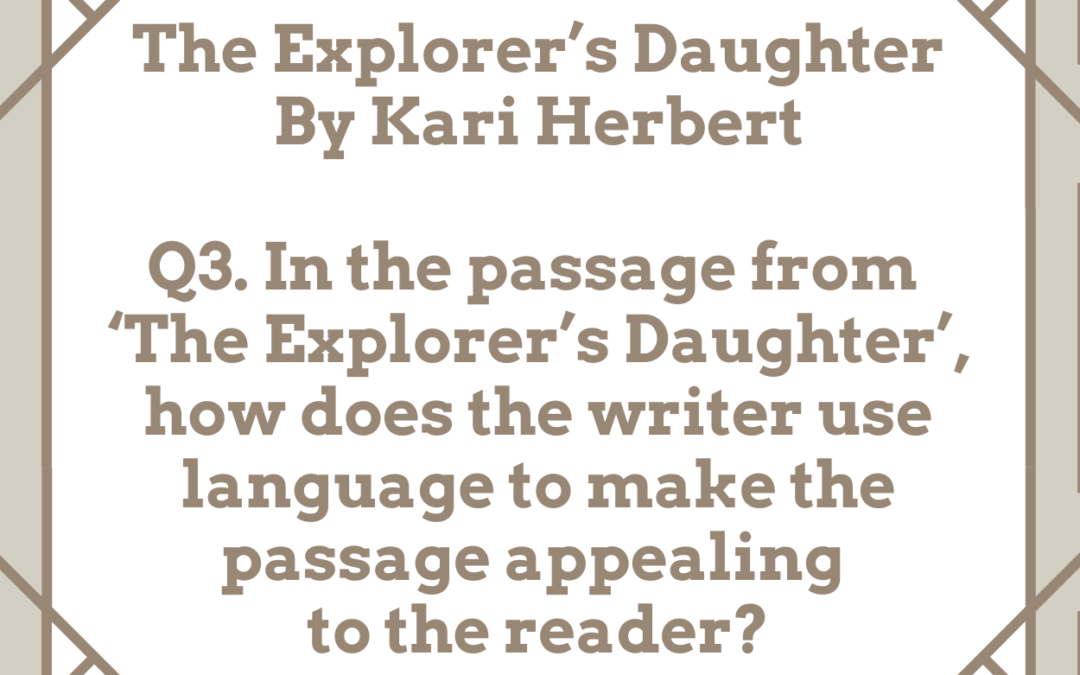Edexcel English IGCSE: Explorer’s Daughter by Kari Herbert
Q3. In the passage from ‘The Explorer’s Daughter’, how does the writer use language to make the passage appealing to the reader?
In your answer, you should think about:
- the descriptions of the Inughuits’ lives;
- the description of the narwhal;
- her feelings towards the hunt.
You should refer closely to the passage to support your answer. You may use brief quotations.
Edexcel English IGCSE Model Essay by an Expert
Kari Herbert uses a variety of language techniques to share with the reader her respect for the Inughuits, the narwhals’ beauty, and her conflicted feelings towards hunting.
Herbert emphasises the Inughuits’ struggle to survive to interest and engage the reader. Throughout the passage, she refers to them as “the hunters”, showing that for them, hunting is not just a hobby; it is crucial to their survival. In the description of the hunt, Herbert says that the hunt “was like watching a vast, waterborne game”, highlighting the teamwork involved. This simile is also ironic, since the hunt is actually serious and dangerous. By emphasising the danger of the hunt, Herbert captures the reader’s attention and makes them interested to see what will happen next. For example, the women’s reactions create tension: they watch the hunters, “spinning round at a small gasp or jump”, capturing their anxiety about their husbands.
Herbert’s descriptions of the narwhals highlight their natural beauty. This is particularly engaging for the reader, since the passage describes their deaths. Herbert describes the stunning beauty of her surroundings, for example with the metaphor “glittering kingdom”, which makes it sound like a rich and magical place. The narwhals themselves contribute to the beauty of the area, with their spray “catching the light in a spectral play of colour”. This poetic, figurative language creates a vivid visual image for the reader, encouraging them to appreciate the beauty of the narwhals, and their suitability for their natural environment. This adds poignancy to the idea that they are being hunted by the Inughuits.
Because Herbert has induced respect for both the narwhals and the Inughuits, the reader is drawn into her conflicting emotions regarding the hunt. Initially, she builds tension about the hunt, encouraging the reader to share her excitement about ‘witnessing’ the event. For example, she was “scrambling” up to the lookout to see it; this vivid vocabulary shows her sense of urgency. However, this excitement becomes more complex as she experiences conflict between her head and her heart: in her head, she “urged the man on”, but in her heart, she “urged the narwhal to dive, to leave, to survive”. The assonance, triple structure and repeated ‘v’ sound draws the reader’s attention to this expression of emotional desire; it encourages the reader to reflect on the implications of such a beautiful creature being slaughtered.
Although Herbert uses language techniques to draw the reader into her emotional conflict, she doesn’t leave the reader in any doubt about whether the hunt should occur. The passage finishes with a simple but decisive statement – “Hunting is still an absolute necessity in Thule” – which persuades the reader that hunting must continue if the Inughuits are to survive.



